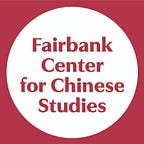The Photography of Sha Fei 沙飞 (1912–1950): New Exhibition at the Fairbank Center
Photography and Propaganda in Wartime China: A new exhibition opens this week at the Fairbank Center as part of our 60th Anniversary celebrations.
Sha Fei’s photographs invoke instantly recognizable images of wartime China. From posters, to newspapers and history text books, his unique portrayal of the instability of the 1930s and 1940s informed a new visualization of CCP propaganda. Curated by Professors Eugene Wang (Harvard University) and Chiao-mei Liu (National Taiwan University), this exhibition explores Sha Fei’s influence on CCP visual culture and Chinese revolution, and is the subject of an upcoming conference at Harvard University on April 22–23: “The Photographer Who Shaped Modern China: Sha Fei and His World.”
Sha Fei’s Photography
Sha Fei’s photography explores what it means to be human during war and the irreversible changes that wartime experiences engrave on the individual. By setting subjects in dynamic poses against massive dramatic scenes, Sha Fei seeks to transcend war’s friend-foe dichotomy and humanize his subject.
His theatrically staged compositions are not just grandstanding, however, but reflect a deep interest in the universality of human emotion, regardless of allegiance. Sha Fei’s photos are therefore, despite their propagandistic use, not only an illustration of history, but also a mechanism of how history is captured and staged with the photographer’s sensibility during extreme circumstances through the lens of a camera.
Who was Sha Fei?
Born Situ Chuan 司徒传 in Guangzhou in 1912, Sha Fei developed his photographic interest when he was assigned to the Shantou Radio Station in Guangzhou Province in 1932, drawing inspiration from photographs in foreign pictorial magazines. His photographs highlight a strong Western influence instilled during his tenure with the Shanghai-based “Black-and-White Photography Association” in 1935, and the Western Painting Department of the Shanghai Art Academy in 1936.
The onset of both civil war and invasion by Japanese forces in the 1930s, however, forced Sha Fei to abandon his idealistic aspirations for art and instead capture the stark realities of wartime. The photographs depicted in this exhibition reflect his personal journey from a sensitive, urbanized artist to a photographer harrowed by his experience of the battlefield.
Sha Fei was executed on March 4, 1950 at age 38 for killing his Japanese doctor, possibly during a seizure induced by post-traumatic stress. Although he is rumored to have given a metal box containing his photographic negatives to a witness at his execution, these negatives were lost and possibly buried with him. The photographic prints on display here were generously donated by Sha Fei’s daughter, Wang Yan, to the Harvard Yenching Library.
This exhibition was curated with assistance from the Fairbank Center for Chinese Studies and Harvard Yenching Library. The exhibition will run at the Fairbank Center (1730 Cambridge Street) until April 22, 2016. For additional photographs, please visit the Fairbank Center website.
For media inquiries regarding the exhibition, please contact James Evans at jamesevans [at] fas.harvard.edu.
